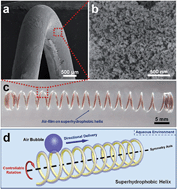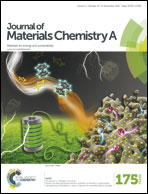Superhydrophobic helix: controllable and directional bubble transport in an aqueous environment†
Abstract
Manipulating air bubbles in an aqueous medium exhibits both scientific and technologic value in gas-collection, selective aeration, and pollutant disposal. Superhydrophobic substrates, known as underwater superaerophilic substrates, offer numerous opportunities to develop advanced gas controlling systems, arising from its strong affinity to air bubbles in water. Herein, we present a superhydrophobic helix that is able to achieve controllable and directional bubble delivery. In an aqueous environment, the bubble tends to stay on the summit of the helix structure and moves along with the helix rotation. The velocity of the bubble delivery can be facilely tuned in terms of the spacing length of the helix. Continuous bubble collection and delivery were realized by integrating the helix with a gas needle and anti-buoyancy transport of the air bubbles was demonstrated using a tilted superhydrophobic helix. Taking advantage of the bubble controllability, a bubble based micro-reaction of H2 and O2 was conducted depending on the special helix structure with two directionalities. This contribution should provide new ideas for the exploration of functional superwettability materials and promote the development of gas-involved multi-phase systems.



 Please wait while we load your content...
Please wait while we load your content...